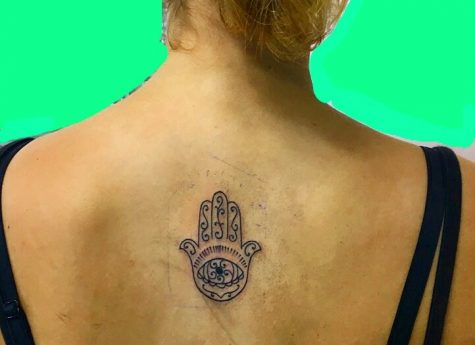The trend piercing the nation
How stick and poke tattoos are bringing creativity, and danger, to students skin
January 9, 2018

The latest tattoo trend, stick and poke, is fascinating teenagers all over the country, but little do they know of the grim side effects.
“Do it yourself is always an attractive concept. But the skin is a very important part of the barrier defense of your body… when you breach it, you’re opening that barrier to all kinds of infectious complications,” says Northwestern University dermatologist Dr. Neill Peters.
According to Vice.com, stick and poke tattooing started among prisoners but has become a popular practice among college and high school students, as it is easily self-administered using regular store bought ink and sewing needles. Although some can last as long as a professional tattoo, stick and pokes generally start to fade depending on the depth and the number of times the tattoo is reapplied, contributing to the appeal it has on teens seeking an alternative route into the tattooing world.
Heewon Kim, a freshman at ETHS, states that the idea of a stick and poke appeals to her as a memento marking a particular time in her life. “I think when you do it, it is significant to the overall meaning of the tattoo. It would have meant something else if I’d gotten it in 5 years, and I wanted to capture and represent the person I was at that moment,”
Other students prefer this method because it’s easy and relatively painless. Kim mentioned that she obtained her supplies from a local art store. She researched online which brand of ink seemed safe to use on the skin.
“Before you do it you have to sterilize the needle and clean your skin…and then after, wrap it with neosporin and a band-aid,” says Kim’s friend, Gaia Grosz. Grosz and Kim applied their first stick and poke tattoos to each other the summer before they started high school.
Another freshman girl admitted that the research she did for her tattoo didn’t seem very reliable. “The sources I used weren’t really that credible. I was a bit skeptical at first but, after my friends did it, it seemed okay,”.
One can always rely on the internet to find whatever information one needs to support one’s beliefs. The real question is how reliable is the information on a given website or video on Instagram. Peters runs through a long list of the unpleasant side effects on the skin that can be caused by the stick and poke method. Viral infections such as warts, HPV, molescum, and the herpes cymplex virus are all included, as well as common allergic reactions to the ink itself.
Furthermore, one can become dissatisfied with the tattoo later in life, resulting in expensive laser removal surgeries. But, as a dermatologist, Peters says his biggest concern by far lies with the serious and almost irreparable damage caused by infections.
Peters suggests that, if you really want a tattoo, it’s better to wait for a professional to apply it than to make a potentially serious mistake in the short term. After all, for most high schoolers, that opportunity is less than three years away.
For additional information go to: https://tonic.vice.com/en_us/article/qvdq3b/how-safe-are-stick-and-poke-tattoos
| Some Tattoo Techniques |
| Hand Poke
Usually small, with only a needle and some ink. Tebroi Tattoo Like an hand poke, but instead of one needle one uses a metal or wooden rod with a bunch of little spikes on the end. Skin Stitch Dye’s a needle and thread, and literally stitches in a design, and then pulls out the thread. Handtap Tattoo A traditional Polynesian design using a hammer or L-shaped tool to ink up skin. |


















